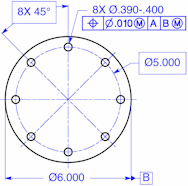COURSE DESCRIPTION
Tolerance Analysis is a course that is presented through lecture, demonstration, discussion, and written exercises. It is an information packed course that will provide participants with the analytical tools needed to:
- Set up a tolerance analysis problem
- Determine the 100% tolerance stack–up in an assembly
- Analyze fixed and floating fastener assemblies
- Use statistical tolerancing
COURSE OBJECTIVES
Participants will be able to:
- Identify factors pertinent to a stack–up analysis
- Simplify complex assemblies
- Draw a loop analysis diagram
- Calculate MAX and MIN GAPS within an assembly
- Calculate the statistical tolerance of an assembly
SUGGESTED PARTICIPANTS
|
|
COURSE OUTLINE
- The Basics
- Identify factors pertinent to stack–up analysis
- Designate positive and negative routes
- Position each part for a worst–case analysis
- Calculate mean dimensions and equal bilateral tolerances
- Calculate virtual and resultant condition boundaries
- Calculate the tolerance of fixed and floating fasteners
- Box Assembly
- Apply basic stack–up analysis to a box assembly
- Draw loop analysis diagram for the box assembly
- Designate positive and negative routes
- Calculate mean dimensions and equal bilateral tolerances
- Calculate MAX and MIN GAP
- Tolerance Stack–Up Analysis for Feature of Size
- Perform a loop analysis
- Determine the start and end points
- Graph values on a loop diagram
- Tolerance Stack–Up Analysis for Assemblies with Plus
and Minus Tolerancing
- Calculate airspaces and interferences
- Alternative method of analysis
- Tolerance Stack–Up Analysis for a Floating Fastener
Assembly
- Calculate resultant and virtual conditions
- Convert all dimensions to equal bilateral tolerances
- Mix widths and diameters in a numbers chart
- Graph the numbers into a tolerance stack–up diagram
- Determine all unknown gaps in a five–part assembly
- Tolerance Stack–Up Analysis for a Fixed Fastener Assembly
- Calculate overall housing requirements
- Calculate MIN and MAX GAPS within the assembly
- Tolerance Stack-Up Analysis for a Five–Part Assembly
- Perform a tolerance analysis of a five–part rotating assembly with a variety of geometric tolerances
- Practice simplifying a complex situation
- Learn to calculate part–to–part analysis from two parts to an infinite number of parts
- Determine assembly housing requirements
- Calculate radial clearance and interference
- The Theory of Statistical Probability
- Convert an arithmetical to a statistical tolerance
- Use the Root Sum Squares (RSS) formula
- Determine the tolerance statistically likely to be consumed
- Compare the statistical to arithmetical tolerance
- Calculate the percentage each tolerance may be increased
- Use a correction factor as a multiplier
- Reintegrate the statistical tolerance into the assembly

 TECHNICAL TRAINING CONSULTANTS
TECHNICAL TRAINING CONSULTANTS